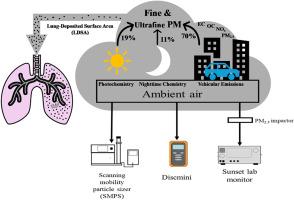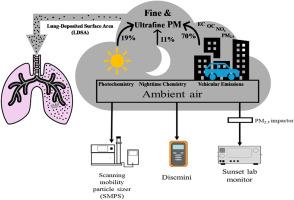洛杉矶城市细颗粒物和超细颗粒物的排放:肺沉积表面积的来源和变化
IF 7.3
2区 环境科学与生态学
Q1 ENVIRONMENTAL SCIENCES
引用次数: 0
摘要
城市环境中空气传播的颗粒物(PM)通过穿透呼吸系统对健康构成重大风险,值得关注的是,作为颗粒物暴露指标的肺沉积表面积(LDSA)。本研究旨在研究洛杉矶不同季节LDSA、颗粒数浓度(PNC)、元素碳(EC)和有机碳(OC)浓度的日变化趋势和来源,以全面了解超细颗粒(ufp)的一次和二次来源的贡献。每小时使用DiSCmini和扫描迁移率粒度仪(SMPS)测量PNC和LDSA,使用Sunset Lab EC/OC监测仪测量OC和EC浓度。结果表明,PNC和EC的日变化趋势明显,高峰出现在清晨和傍晚,这与交通量增加的时期一致。在较温暖的时期,由于光化学反应,观察到中午PNC增加。相比之下,寒冷月份的夜间峰值表明,次生气溶胶是通过水相化学形成的。此外,DiSCmini报告的LDSA值始终高于SMPS,这表明存在不规则形状的ufp,特别是在交通流量大的时期。正矩阵分解(PMF)分析确定了三个主要来源。因子1(光化学影响过程)在较暖时期由二次有机气溶胶形成驱动,贡献了19%的LDSA。因子2,其中主要交通影响排放是主要贡献者,占LDSA的70%,并与高负荷的OC(61%)、EC(78%)和NOx(94%)相关。在较冷的月份,因子3(水相二次过程影响排放)占LDSA的11%。因子1和因子3源对OC4的贡献相当(分别为52%和48%),强调了它们在二次气溶胶形成中的作用。这些研究结果强调,有必要同时解决初级和次级排放问题,以减轻与超射灯接触有关的健康风险。本文章由计算机程序翻译,如有差异,请以英文原文为准。


Urban emissions of fine and ultrafine particulate matter in Los Angeles: Sources and variations in lung-deposited surface area
Airborne particulate matter (PM) in urban environments poses significant health risks by penetrating the respiratory system, with concern over lung-deposited surface area (LDSA) as an indicator of particle exposure. This study aimed to investigate the diurnal trends and sources of LDSA, particle number concentration (PNC), elemental carbon (EC), and organic carbon (OC) concentrations in Los Angeles across different seasons to provide a comprehensive understanding of the contributions from primary and secondary sources of ultrafine particles (UFPs). Hourly measurements of PNC and LDSA were conducted using the DiSCmini and Scanning Mobility Particle Sizer (SMPS), while OC and EC concentrations were measured using the Sunset Lab EC/OC Monitor. The results showed distinct diurnal trends in PNC and EC, with peaks occurring in the early morning and evening, which were consistent with periods of increased traffic volume. During warmer periods, a midday increase in PNC was observed, attributed to photochemical reactions. In contrast, a nighttime peak during colder months suggested the formation of secondary aerosols through aqueous-phase chemistry. Additionally, the DiSCmini consistently reported higher LDSA values than SMPS, indicating the presence of irregularly shaped UFPs, particularly during periods of heavy traffic flow. Positive Matrix Factorization (PMF) analysis identified three primary sources. Factor 1 (photochemically influenced processes), driven by secondary organic aerosol formation during warmer periods, contributed to 19% of LDSA. Factor 2, in which primarily traffic influenced emissions were the dominant contributor, accounting for 70% of LDSA and associated with high loadings of OC (61%), EC (78%), and NOx (94%). Factor 3 (aqueous phase secondary process influenced emissions) during colder months, accounted for 11% of LDSA. Both Factor 1 and 3 sources exhibited comparable contributions of OC4 (52% and 48%, respectively), underscoring their roles in secondary aerosol formation. These findings emphasize the need to address both primary and secondary emissions to mitigate health risks associated with UFP exposure.
求助全文
通过发布文献求助,成功后即可免费获取论文全文。
去求助
来源期刊

Environmental Pollution
环境科学-环境科学
CiteScore
16.00
自引率
6.70%
发文量
2082
审稿时长
2.9 months
期刊介绍:
Environmental Pollution is an international peer-reviewed journal that publishes high-quality research papers and review articles covering all aspects of environmental pollution and its impacts on ecosystems and human health.
Subject areas include, but are not limited to:
• Sources and occurrences of pollutants that are clearly defined and measured in environmental compartments, food and food-related items, and human bodies;
• Interlinks between contaminant exposure and biological, ecological, and human health effects, including those of climate change;
• Contaminants of emerging concerns (including but not limited to antibiotic resistant microorganisms or genes, microplastics/nanoplastics, electronic wastes, light, and noise) and/or their biological, ecological, or human health effects;
• Laboratory and field studies on the remediation/mitigation of environmental pollution via new techniques and with clear links to biological, ecological, or human health effects;
• Modeling of pollution processes, patterns, or trends that is of clear environmental and/or human health interest;
• New techniques that measure and examine environmental occurrences, transport, behavior, and effects of pollutants within the environment or the laboratory, provided that they can be clearly used to address problems within regional or global environmental compartments.
 求助内容:
求助内容: 应助结果提醒方式:
应助结果提醒方式:


